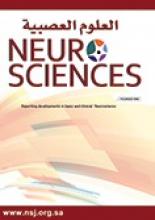Abstract
OBJECTIVE: To evaluate the electrophysiological changes, blood flow index, vascular endothelial growth factor (VEGF), soluble fatty acid synthase (s-FAS), and intercellular adhesion molecule (I-CAM) in diabetic neuropathy.
METHODS: This study was conducted from March 2004 to November 2007 on 60 type II diabetic patients and 30 controls, recruited from the Diabetic Research Center of King Abdul-Aziz University Hospital, Riyadh, Kingdom of Saudi Arabia. Electrophysiological studies were carried out in the Clinical Physiology Laboratory. Patients and controls were of the same age, gender, and weight.
RESULTS: The study included 30 controls (group I), 30 diabetics type II without complications (group II), and 30 with peripheral neuropathy (group III). There was a significant decrease of motor conduction velocity, prolongation of F wave response of median, ulnar, peroneal nerves, significant decrease of median and ulnar sensory conduction velocity, sural nerve conduction velocity and sensory amplitude, showed significant decrease, ankle/brachial index (A/BI) showed insignificant change, also there was a significant increase of plasma VEGF, s-FAS, and ICAM all in group III compared to groups I and II. The results revealed that VEGF and s-FAS are good predictors for median nerve motor conduction velocity, also VEGF is a good predictor of sural nerve sensory conduction velocity in diabetic neuropathy.
CONCLUSION: The rise of VEGF in diabetic neuropathy may be protective to preserve the nerve blood flow, the significant rise of s-FAS may be causative in advancement of neuropathy, I-CAM high levels suggest its leading role in interaction between endothelium, blood elements, and peripheral nerves. The results showed that human neuropathy is the result of multiple factors, thus, it may be optimistic to believe that reversing one of them, such as s-FAS will halt, or reverse nerve damage. Targeting multiple mechanisms simultaneously, by administering combination treatments of VEGF, and anti-apoptotic drugs may be prospective.
- Copyright: © Neurosciences
Neurosciences is an Open Access journal and articles published are distributed under the terms of the Creative Commons Attribution-NonCommercial License (CC BY-NC). Readers may copy, distribute, and display the work for non-commercial purposes with the proper citation of the original work.






